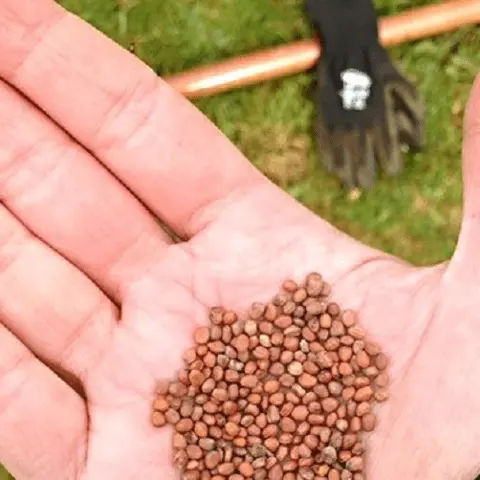Contents
Watermelon radish is an unusual hybrid, somewhat similar to radish, bred in China. The variety has a good yield, it is not very susceptible to diseases and pests, it ripens quickly, and contains many vitamins. The main reason for the popularity of the variety was the intriguingly bright appearance of the root crop on the cut. Initially, it was used to decorate the table, decorate dishes and drinks, and later taste qualities were appreciated.
Benefits of watermelon radish
Watermelon radish is rich in vitamins B, C, PP and A. It contains a large amount of folic acid, iron, calcium, fluorine, magnesium, as well as dietary fiber necessary for the normalization of the digestive tract, proteins and sugar. Magnesium and calcium are important for blood vessels and the heart. The presence of active enzymes and amino acids normalizes metabolic processes in the body, improves appetite, and restores the immune system after winter.
The use of watermelon radish in large quantities is contraindicated for people suffering from diseases of the kidneys, liver and digestive system. The irritated mucous membrane will certainly respond with acute pain.
Description of watermelon radish
Watermelon radish is a hybrid of radish and radish. Root crops of oblong or round shape with light green skin and unevenly colored raspberry flesh with small black seeds.

For radishes, root crops are quite large, about 8 cm in diameter and weighing 100-200 g. The rosette is erect with dark green, medium-sized leaves serrated along the edge. The scarlet pulp is juicy, slightly spicy. The taste is unusual: the outside is bitter, and the core of the root crop is sweet. Bitterness comes from the mustard oil under the skin. And the more its content in a vegetable, the more bitter it is. Compared to conventional radishes, they are firmer and less crunchy.
Main characteristics
The variety is cold-resistant, withstands frosts down to -6 ºС. The growing season is short, producing several crops per season. The best temperature regime for growing watermelon radish is +23 ºС. The vegetable is moisture-loving – in insufficiently moistened soil, growth is inhibited, it shoots, and the roots become flabby.
As it matures, the intensity of its taste decreases. The shelf life is short, the energy value of the product is 20 kcal.
Productivity
The yield of watermelon radish is high. Subject to the rules of cultivation, you can get about 10 kg per 1 sq.m. From germination to full ripening of the root crop, 30 days pass. It is necessary to harvest at the moment of full technical maturity, in the evening or early in the morning, preferably in dry weather. After collecting the radish, it is left to dry in the beds until the end of the day.
Productivity largely depends on timely and high-quality watering. Violation of the water regime worsens the germination, growth and quality of the crop. The largest harvest of watermelon radish is harvested when seeds are sown in early July.
Advantages and disadvantages
Watermelon radish, like any other crop, has its advantages and disadvantages.
The positive qualities include:
- cold resistance;
- high yield;
- resistance to pests and diseases;
- friendly germination;
- rapid ripening of root crops;
- low calorie content.
Among the shortcomings are the following:
- gradual loss of taste;
- short storage times.
Rules of landing and care
In greenhouses, watermelon radish seeds can be planted from mid-March. It is very convenient to use egg boxes for sowing.
Sowing in open ground is carried out in May, when the earth warms up to + 8 + 15 ° С. And then in July and early August. To speed up the germination of seeds, it is necessary to soak them for a day in cold water. It is preferable to sow large seeds.

Watermelon radish loves clay or sandy soils in well-lit areas, but slightly darkened by trees or shrubs, as it is a short-day culture. From a long stay in the sun, he goes to the arrow. If the beds for planting are on the sunny side, you need to artificially darken the plant.
A bed for crops is prepared in the fall. The best predecessors for watermelon radishes are potatoes, tomatoes or cucumbers. After carrots, beets or cabbage, it is not recommended to sow it. Compost (10 liters per 1 sq. M) and phosphorus-potassium fertilizer, or 4 kg of manure are added to the soil dug up on a spade bayonet, then the bed is mulched with sawdust or peat, and left until spring.
In slightly moist soil, two seeds are planted in a recess, maintaining a distance of about 8 cm between adjacent holes. Watermelon radish does not tolerate dense plantings, so it can dry out, and the root crops will turn out to be tasteless. When forming furrows, it is necessary to observe a distance of 10-15 cm. You need to deepen the seeds by 2 cm. If you deepen more, they will germinate later. After filling the holes with earth, and after watering with water at room temperature, shoots can be expected in 3-4 days.
Peculiarities of growing
Watermelon radish is very picky about watering. The abundance and regularity of soil moisture is the key to a good and high-quality harvest. It needs to be watered as it dries. So that the radish does not dry out, on hot days it is advisable to water the beds twice – in the morning and in the evening. With frequent rains, moisturize 2 times a week. The last watering is carried out 5 hours before harvesting, then it will be stored longer.
Irregular irrigation will make the radish hollow, lack of moisture will lead to bolting, deterioration in taste and stiffening of the root crop, and fungal diseases will result from overmoistening of the soil.
At first, shoots of watermelon radish need to be loosened every 3-4 days, while removing weeds to provide oxygen to the roots. Later, the procedure is carried out after each watering. To retain moisture in the soil, it is advisable to regularly mulch the cultivated land. In addition, the mulch will protect crops from overheating on hot days.
When sprouts with three true leaves appear, they must be thinned out, leaving the strongest ones.

An important point in the cultivation of watermelon radish is the obligatory shading of the culture, otherwise the root crops will be very bitter.
Pests and diseases
Watermelon radishes are considered disease and pest resistant, but improper care and inappropriate soil can cause clubroot, downy mildew, and blackleg. The first is caused by inappropriate soil acidity. It is determined by the roughness and ugliness of the root crop, the lack of taste in it. The second arises from an excess of moisture in the soil. Compliance with the irrigation regime and frequent loosening of the ridges will help prevent their occurrence.
Of the pests, watermelon radish can hit:
- Wireworm – it damages roots. If the seedlings are weeded in a timely manner, then its appearance can be avoided, since the pest larvae live on the roots of weeds.
- Cabbage fly and cruciferous flea feed on leaves and can cause significant damage to radishes at the end of the growing season. You can prevent their appearance by covering the crops before the formation of the first leaf with a covering material. From the pests that have already settled on the foliage, an infusion of garlic, tomato tops and ash will help get rid of.
Cooking application
Watermelon radish can be used to prepare various dishes: vegetable stews, meat and fish dishes, salads.

You can add both the root crop and its tops to the salad. Vegetables are baked, stewed, fried, boiled, mashed, cold soups and okroshka are made from it. Perfectly emphasize its unusual taste of cream. The low calorie content of watermelon radish allows it to be used in diet recipes.
The brightness and beauty of the pulp is the main advantage of the vegetable. It is used for cutting, decorating cocktails, desserts, sandwiches. Sandwiches with watermelon radish sprinkled with black salt and sesame seeds look spectacular.
Conclusion
Watermelon radish cannot be called an unpretentious crop, but subject to the conditions of cultivation and care, it gives a large harvest. Its attractive bright flesh and specific taste attracts gardeners to experiments. It is versatile in cooking, can be a table decoration.









